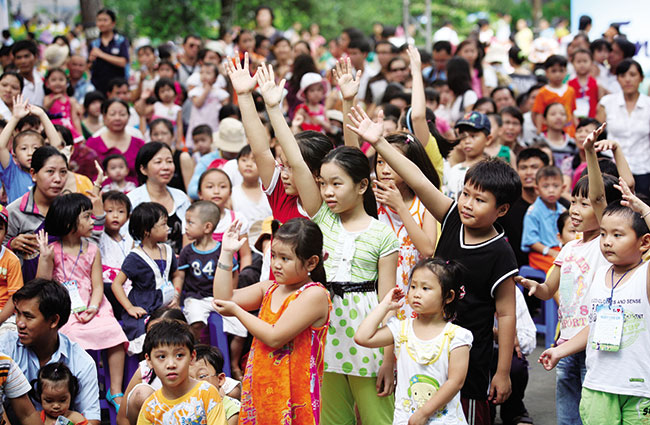Vietnam makes progress on MDGs

While more work lies ahead, Vietnam has made major strides forward in its UN goals
The General Statistics Office (GSO) and the UN Children’s Fund have released a 2014 multiple indicator cluster survey (MICS) for Vietnam which illustrates some of the country’s achievements in securing its Millennium Development Goals (MDGs), especially in terms of nutrition, immunisation, water and sanitation, maternal and newborn health, and education.
According to the survey, the percentage of infants under six months of age who are exclusively breastfed has increased from 17 to 24 per cent over the last five years.
Immunisation is another key area in achieving MDG 4 objectives to reduce child mortality by two-thirds by 2015. The survey showed that over 82 per cent of Vietnamese children aged 12-23 months are fully vaccinated.
MDG 5 is aimed at reducing the maternal mortality ratio by three quarters. One of the main strategies to this end is eliminating maternal and neonatal tetanus. In Vietnam, more than 82 per cent of women are immunised against tetanus.
The UN goals highlight safe drinking water and sanitation as basic necessities for good health and early child development. Under the survey, overall, 92 per cent of the population has access to improved sources of drinking water – 98 per cent in urban areas and 89 per cent in rural areas. Additionally, over 79 per cent of households are now using improved sanitation facilities.
The MICS 2014 also showed that nearly 94 per cent of Vietnamese women delivered their babies with the assistance of skilled birth attendants. The survey also highlights the fact that more than 56 per cent of women who gave birth in the last two years had access to basic antenatal care which includes three key aspects: blood pressure, blood, and urine tests.
GSO deputy director general Nguyen Van Lieu stressed that Vietnam had also made huge strides forward in the field of education.
“Education is a vital prerequisite for combating poverty, empowering women, protecting children from hazardous and exploitative labour and sexual exploitation, protecting the environment, and influencing population growth,” he said.
Across the country, at primary education level, only 2 per cent of children are not enlisted in school.
However, the survey underscored the unfinished agenda for children.
For example, one of the overarching objectives of the MDGs is to reduce the mortality rate of children under five. Results from MICS 2014 highlight continuing disparities in under-five mortality rates among vulnerable populations. With every 1,000 live births, 20 children die before their fifth birthday. In rural areas, the under-five mortality rate stands at 22 per 1,000 live births. Meanwhile, ethnic minority populations have the highest rates at 43 deaths per 1,000 live births.
In term of HIV/AIDS and sexual behaviour, more than 56 per cent of women aged 15-49, and 50 per cent of women aged 15-24 years have insufficient HIV/AIDS knowledge. Additionally, only 46 per cent of women aged 15-49 years are aware of the three ways of mother-to-child transmission (during pregnancy, delivery, and through breastfeeding).
What the stars mean:
★ Poor ★ ★ Promising ★★★ Good ★★★★ Very good ★★★★★ Exceptional
Latest News
More News
- Vietnam shows potential as global AI hub (August 24, 2024 | 10:00)
- Business breakthroughs made through innovation and renovation (August 23, 2024 | 11:08)
- Tax authorities to put retailers selling through livestreaming under scrutiny (August 22, 2024 | 10:32)
- President of Australian Senate to pay official visit to Vietnam (August 22, 2024 | 10:01)
- Cross-border e-commerce to be boosted (August 21, 2024 | 10:41)
- Consumer finance regains growth momentum (August 20, 2024 | 10:05)
- Vietnam advised to develop aviation supporting industries (August 17, 2024 | 12:30)
- Ba Ria-Vung Tau to become a global logistics hub (August 16, 2024 | 17:31)
- New car sales hit yearly high of 29,000 in July (August 16, 2024 | 13:31)
- South Korea and Vietnam complete $5.5 million Smart City Cooperation Centre in Hanoi (August 16, 2024 | 09:46)

















 Mobile Version
Mobile Version